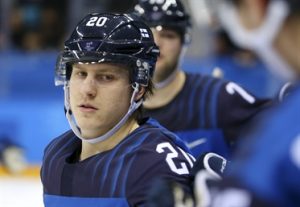Finnish forward Eeli Tolvanen after a goal against Germany in the preliminary round. Photo: Andre Ringuette / HHOF-IIHF Images
The Jokerit Helsinki winger leads the scoring race with nine points. In the preliminary round, he put up six points (3-3-6) in three games, outpacing such established KHL stars as Ilya Kovalchuk (4-1-5), Pavel Datsyuk (0-0-2) and Sergei Mozyakin (1-2-3). Tolvanen had a goal and three assists as Finland beat Germany 5-2, and scored twice in a 5-1 win over Norway.
More crucially, Tolvanen added three assists in Tuesday’s 5-2 do-or-die playoff victory that eliminated host Korea. So he may have missed out on playing for Boston University due to his grades, but he’s getting an A at this tournament.
“Eeli is a great player with an unbelievable shot,” said Finnish head coach Lauri Marjamaki. “He brings us so much, his open-minded game and fearless (approach to the game). And the whole atmosphere is excited because Eeli is on our team.”
While Nashville Predators fans are excited about the possibility that the 179-cm, 82-kg gunner (drafted 30th overall in 2017) could jump to the NHL after the KHL season, let’s step back and establish how he stacks up as a Finnish national team member and European pro in comparison to Kurri, Selanne and Laine at a similar age.
At the 1980 Olympics in Lake Placid, Kurri, the second-youngest player on his team at age 19, had a limited impact. The Finns, under head coach Kalevi Numminen (Teppo Numminen’s father), had a shot at medaling, but finished fourth after a closing 4-2 loss to the champion United States. Two other forwards on that team made the NHL: captain Jukka Porvari and Mikko Leinonen. Kurri got three points (2-1-3), but all came in a 10-3 rout of the Netherlands, which finished ninth in its lone Olympic appearance.
So Wayne Gretzky’s future linemate, who had tied for the 1980 World Junior scoring lead (11 points) in a silver-medal run the month before, still had some growing to do.
Admittedly, Tolvanen, who made the 2016 U18 all-star team with a tournament-high seven goals in Finland’s gold medal run, hasn’t shone as brightly as Kurri did in World Junior play. Even though the Sioux City Musketeers star finished with over a point per game in his World Junior career (3-9-12 in 11 games), the Finns placed ninth and sixth in his 2017 and 2018 appearances respectively.
But turning back to the Olympics, even if you argue that Kurri had to face future IIHF Centennial All-Star team members like Valeri Kharlamov, Sergei Makarov, and Vyacheslav Fetisov on the Soviet team (in other words, some higher-calibre opponents than Tolvanen is confronting here in Korea), Tolvanen has unquestionably already done more.
“Everybody can see he’s enjoying the hockey,” said Finnish captain Lasse Kukkonen, a four-time Olympian. “He’s playing the hockey that everybody wants to play, having fun and doing the things he loves out there.”
How about Selanne? That Jokerit star did not make the 1988 silver-medal Finnish Olympic team in Calgary. (He would have been 17 at that tournament, and wouldn’t even make his World Junior debut until 1989 in Anchorage, Alaska.) For context, Finland’s leading scorer at the Calgary Olympics was longtime Tappara Tampere star Erkki Lehtonen (4-6-10), and other notables up front included Janne Ojanen and Esa Keskinen. As with Kurri’s 1980 run, the Finns were up against the best Soviets and Czecholoslovaks.
Selanne was selected tenth overall by the Winnipeg Jets in the 1988 NHL Draft, and waited four years before jumping to the NHL. While the “Finnish Flash” shone at the 1992 Albertville Olympics with a tournament-high seven goals (7-4-11), he was 21 by then. So it’s hard to compare that Selanne to an 18-year-old Tolvanen.
At 17, it would have been challenging for Selanne to make the ‘88 team. That season, he was averaging two points per game with Jokerit’s U20 squad – in a more offensive era. Conversely, Tolvanen, with 34 points this season, has already surpassed Yevgeni Kuznetsov’s 2011 record for the most points by a U20 KHL player (32 points). Playing against men, that’s a more impressive achievement.
So you can argue that Tolvanen is slightly further ahead than Selanne at this stage.
Finally, we all know that if circumstances were different, Laine, who is one year older than Tolvanen, would be on the 2018 Olympic team. Who’s the better winger? Frankly, it would be very hard to choose Tolvanen right now over a guy who dominated the 2016 World Juniors in Finland en route to gold, was named the 2016 World Championship MVP, and would have won the Calder Trophy with the Winnipeg Jets if not for the force of nature known as Auston Matthews.
To put this in terms of goals-per-game, Laine’s 63 goals in 132 NHL games (0.477) currently places him just behind Kurri (0.480) and just ahead of Selanne (0.471). Let that sink in for a moment.
Maybe the Finns will win the Olympic gold medal, Jokerit will win the Gagarin Cup, and then Nashville will win the Stanley Cup as Tolvanen comes in late and scores 20 goals to beat Kurri’s playoff record (19 in 1985) shared with Philadelphia’s Reggie Leach (1976).
Ahem. Or maybe we are getting way ahead of ourselves and it’s just crazy to compare an 18-year-old who’s having his first great season against men with two Hall of Famers and an established NHL and international star. Only time will tell.
Either way, the mere possibility of this discussion speaks volumes about the rich crop of talent that modern Finnish hockey is producing.
Tolvanen, a man of few words, showed his confidence when asked to assess Finland’s chances at the Olympics: “We can go all the way.”

